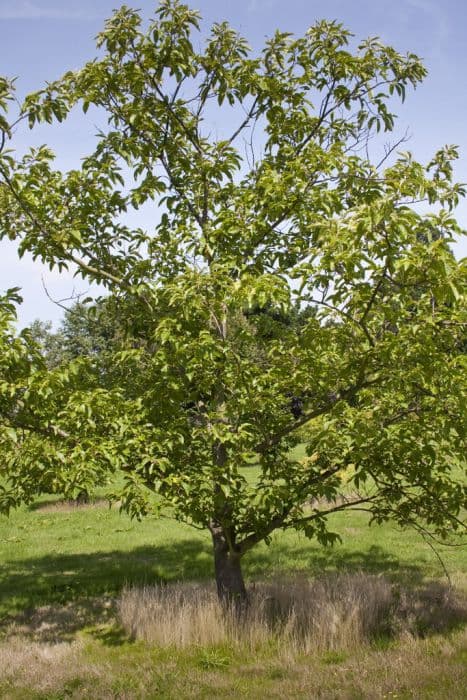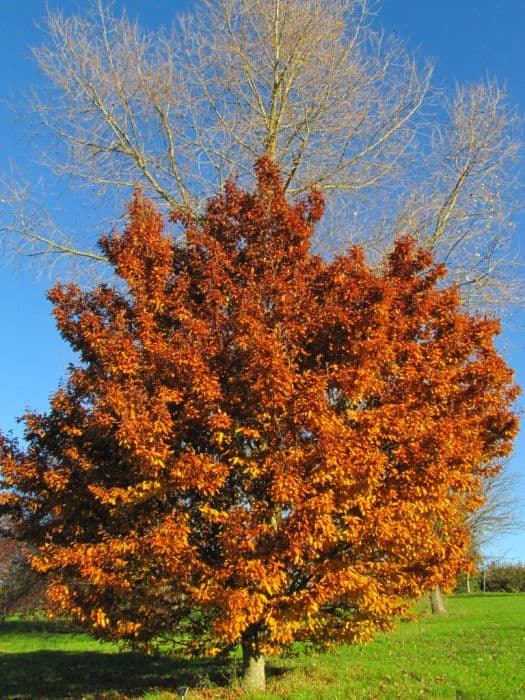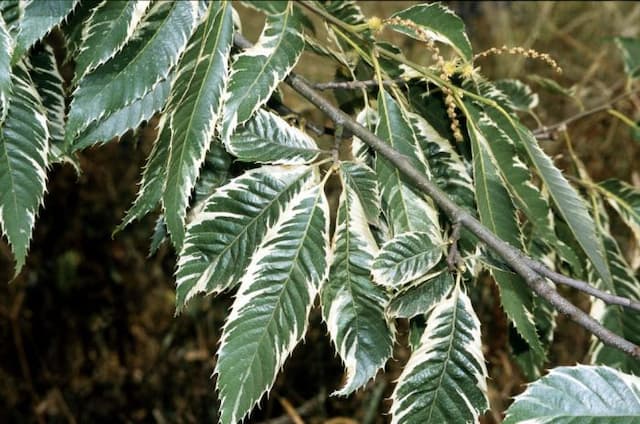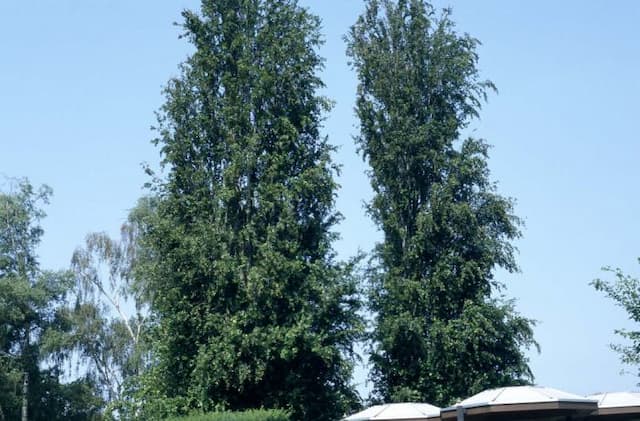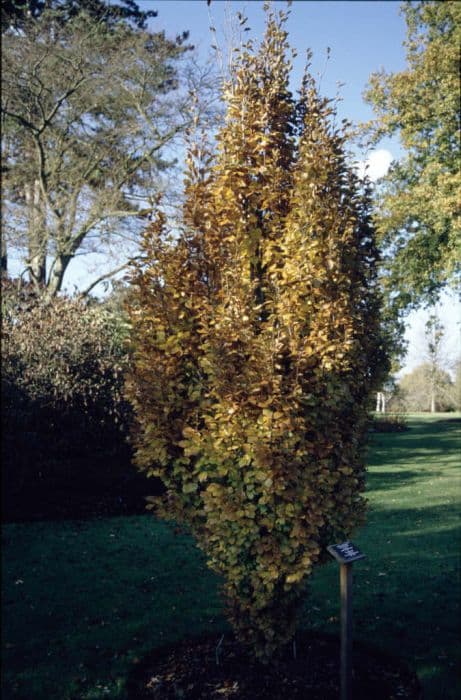Hungarian Oak Quercus frainetto
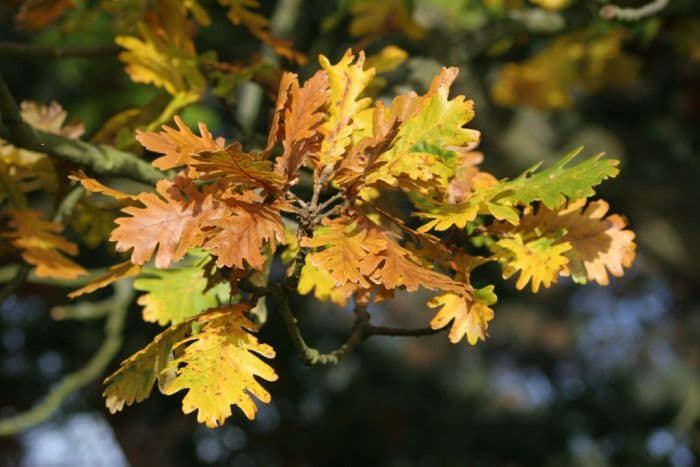
ABOUT
The plant commonly known as the Hungarian oak is a deciduous tree that boasts a robust and rounded canopy. It is characterized by its large, lobed leaves which are usually glossy green on the top and display a hairy texture on their underside, giving them a somewhat soft feel. The leaves turn to a warm brown or yellow shade in the autumn, providing a vibrant seasonal display. Flowers of this oak are not showy as they are catkins, which are long, slender flowering structures, and these typically emerge in spring. Following the flowers, the tree develops its fruit, commonly known as acorns. These acorns have a classic shape with a tough, woody cap that partially encases the smooth, hard nut inside, and they are a food source for a variety of wildlife. The bark of the Hungarian oak is another distinct feature; it is deeply furrowed and has a rugged texture with a dark brown to gray color that becomes more pronounced and characteristically ridged with age. These features create a striking, picturesque form that is commonly seen in parks and large landscapes where its beauty and grandeur can be fully appreciated.
About this plant
 Names
NamesFamily
Fagaceae
Synonyms
Hungarian Oak, Italian Oak
Common names
Quercus conferta, Quercus farnetto, Quercus hungarica, Quercus lanuginosa, Quercus parnassica, Quercus perrini, Quercus robur subsp. frainetto, Quercus sessiliflora K.Koch, Quercus toza Guillet ex Bosc.
 Toxicity
ToxicityTo humans
Hungarian oak, more widely known as the Quercus frainetto, is not commonly classified as a toxic plant to humans. However, as with many oak trees, its acorns and leaves contain tannins, which can be harmful in large quantities. Human ingestion of large amounts of tannins can lead to stomach discomfort, nausea, vomiting, and diarrhea. It's rare for people to consume enough oak plant parts to cause severe poisoning, but caution is advised to prevent any potential adverse effects from large doses.
To pets
Hungarian oak (Quercus frainetto) has the potential to be toxic to pets, particularly dogs, if ingested in significant quantities. The acorns and leaves of the Hungarian oak contain tannins, which in high concentrations can cause gastrointestinal distress in pets, leading to symptoms such as vomiting, diarrhea, abdominal pain, and decreased appetite. In severe cases, ingestion of large quantities of acorns could result in kidney damage or other complications due to the tannic acid. It is important to monitor pets and prevent them from eating acorns or large amounts of oak leaves to avoid these risks.
 Characteristics
CharacteristicsLife cycle
Perennials
Foliage type
Deciduous
Color of leaves
Green
Height
60-80 feet (18-24 meters)
Spread
40-60 feet (12-18 meters)
Plant type
Tree
Hardiness zones
5-9
Native area
Europe
Benefits
 General Benefits
General Benefits- Shade Provider: Quercus frainetto, commonly known as the Hungarian oak, offers extensive canopy cover that creates shaded areas, making outdoor environments cooler and more comfortable.
- Ecological Support: This species contributes to biodiversity by providing habitat and food for various wildlife, including birds and insects.
- Soil Erosion Control: With its extensive root system, the Hungarian oak helps stabilize the soil, reducing erosion and improving soil structure.
- Beauty and Aesthetics: Hungarian oak trees add visual appeal to landscapes with their grand stature and seasonally changing foliage.
- Wood Production: The wood of Quercus frainetto is valued for its quality and durability, used in furniture making and interior woodworking.
- Carbon Sequestration: Like other trees, the Hungarian oak captures carbon dioxide from the atmosphere, helping to mitigate the effects of climate change.
- Cultural and Historical Significance: Many oak species, including Hungarian oak, hold cultural value and are often found in parks, estates, and historic landscapes.
 Medical Properties
Medical PropertiesThis plant is not used for medical purposes.
 Air-purifying Qualities
Air-purifying QualitiesThis plant is not specifically known for air purifying qualities.
 Other Uses
Other Uses- Woodworking: Quercus frainetto, commonly known as Hungarian oak, provides valuable timber that is often used in furniture making, flooring, and veneer production due to its durability and attractive grain.
- Tannin Extraction: The bark of Hungarian oak is a source of tannins which are used in the leather tanning industry to turn animal hides into leather.
- Landscape Design: Hungarian oak is used for ornamental purposes in parks and large gardens, admired for its majestic appearance and broad canopy.
- Wildlife Habitat: The tree offers habitat and food for various wildlife species including insects, birds, and squirrels which benefit from its acorns and sheltering branches.
- Ink Production: Historically, the galls produced by wasps on the leaves of Hungarian oaks have been used to make iron gall ink, a traditional and archival-quality writing ink.
- Dye Source: The bark and leaves of the Hungarian oak can be used to extract natural dyes for coloring fabrics and other materials.
- Barrel Making: Due to its tight grain and flavor properties, the wood is sometimes utilized in cooperage for making wine and whiskey barrels, imparting subtle flavors to the aged beverages.
- Wood Carvings: The hard wood of Hungarian oak is suitable for detailed carvings and is used by artisans to create sculptures and decorative items.
- Acorn Flour: Acorns from Quercus frainetto can be processed to make acorn flour, which is a traditional food in some cultures, although it is less common today.
- Biodiversity Conservation: Planting Hungarian oaks can contribute to the conservation of local biodiversity, providing ecological balance and enhancing the resilience of ecosystems.
Interesting Facts
 Feng Shui
Feng ShuiThe Hungarian oak is not used in Feng Shui practice.
 Zodiac Sign Compitability
Zodiac Sign CompitabilityThe Hungarian oak is not used in astrology practice.
 Plant Symbolism
Plant Symbolism- Strength and Durability: Quercus frainetto, more commonly known as the Hungarian oak, is a species within the genus Quercus, which symbolizes strength due to its hard and solid wood that has been used historically in building and ship-making.
- Longevity: The Hungarian oak can live for several centuries, making it a symbol of longevity and enduring presence through time.
- Nobility: Oaks, in general, have been associated with nobility and have often been planted on estates of the European gentry, giving the Hungarian oak a regal connotation.
- Wisdom: Because of their age and stature, oaks like the Hungarian oak are frequently considered symbols of wisdom and knowledge.
- Stability: Its deep root system makes the Hungarian oak a symbol of stability and grounding, representing a strong foundation.
 Water
WaterThe Hungarian oak (Quercus frainetto) prefers moderate watering, making sure the soil is moist but not waterlogged. During the growing season, it's advisable to water the tree once a week with approximately 1-2 gallons of water, depending on the size of the tree and the weather conditions. For established trees, deep watering every two to three weeks may be sufficient; young trees may require more frequent watering to establish their root systems. It's crucial to allow the soil to dry out slightly between waterings to prevent root rot.
 Light
LightThe Hungarian oak thrives in full sun, meaning it should be planted in a location where it receives at least 6 hours of direct sunlight daily. It is adaptable to a variety of light conditions but will grow best and develop a strong structure when planted in an unobscured area that gets plenty of sunshine throughout the day.
 Temperature
TemperatureHungarian oak is capable of withstanding a wide range of temperatures once established and is hardy in USDA zones 5 through 8. The tree can survive in temperatures as low as -20°F and as high as 100°F. The ideal temperature range for optimal growth is between 60°F and 80°F.
 Pruning
PruningPruning the Hungarian oak is important for removing dead or diseased branches and shaping the tree for a more attractive silhouette. The best time to prune is in the late winter or early spring before the new growth starts. Pruning should be done sparingly as over-pruning can stress the tree, and it's typically recommended to only remove up to 25% of the tree's canopy at one time.
 Cleaning
CleaningAs needed
 Soil
SoilThe Hungarian Oak prefers well-draining loamy soil with a pH of 5.5-7.5. A mix of garden soil, compost, and perlite or sand would create an ideal growing medium that supports its growth by providing adequate drainage and nutrients.
 Repotting
RepottingHungarian Oaks, being large trees, are not typically repotted. As they mature, they should be planted outdoors where they can spread their roots indefinitely without the need for repotting.
 Humidity & Misting
Humidity & MistingHungarian Oaks are adaptable to a range of humidity conditions and do not require specific humidity levels, making them quite resilient outdoors where humidity fluctuates naturally.
 Suitable locations
Suitable locationsIndoor
Hungarian Oak is not suitable for indoor growth due to its size.
Outdoor
Plant in sunny spot with well-draining soil; water and mulch well.
Hardiness zone
5-8 USDA
 Life cycle
Life cycleQuercus frainetto, commonly known as Hungarian oak, begins its life cycle with acorn germination, occurring in spring under suitable moisture and temperature conditions. Seedlings establish a taproot system and begin to grow a straight stem with starter leaves, utilizing stored nutrients in the acorn. As a sapling, the plant continues to develop its root system and increases in height and girth; it forms a canopy of lobed leaves and starts photosynthesizing independently. The tree matures over several decades, developing a thick trunk, robust branching structure, and begins producing acorns typically after 20-30 years. It enters a long reproductive stage where it produces acorns annually, which are dispersed by wildlife and gravity. Finally, as a part of its senescence stage which can occur after several centuries, the tree will show reduced growth and reproductive output, eventually leading to its death.
 Propogation
PropogationPropogation time
Spring-Early Summer
Propogation: The most popular method of propagating the Quercus frainetto, commonly known as the Hungarian Oak, is through seed sowing. This process usually begins with the collection of acorns in the fall, immediately after they drop to ensure freshness and highest viability. The acorns should be planted about 1 to 2 inches deep in well-draining soil and spaced several inches apart to allow room for growth. Stratification, a cold treatment usually applied to mimic winter conditions, is often recommended to break dormancy and encourage germination; this involves storing the acorns at a temperature of 33-41°F (0.6 - 5°C) for 1-2 months. Once stratified, the seeds can be sown outdoors in spring as temperatures begin to rise, resulting in the emergence of seedlings within a few weeks, provided the soil is kept consistently moist.
